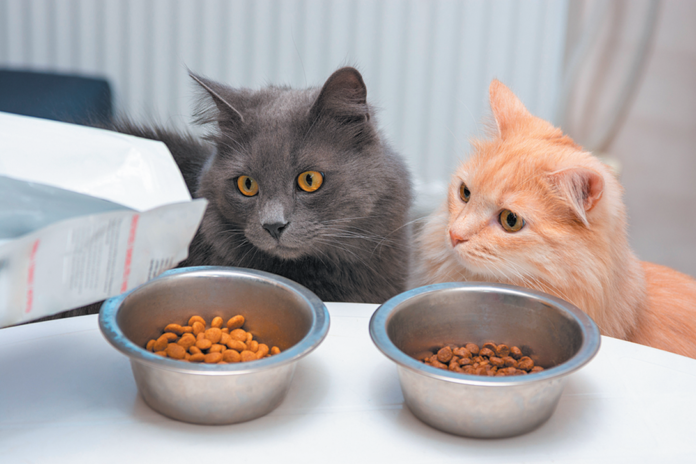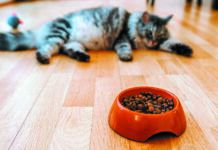One of your cats has heart disease and needs a low-sodium diet. The other is overweight and requires less food than the one with the compromised heart — but she is aggressive about food and will do whatever she can to get it. How do you keep them away from each other’s meals when their optimal health — and maybe even the quality and length of their lives — is at stake?
Cases of cats getting into each other’s food when there are medical conditions at issue is a common reason people come to see Tufts board-certified veterinary nutritionist Deborah Linder, DVM. Throw a pet dog into the mix with his own nutritional issues, and the complications multiply. Cats don’t care about what species a food is intended for. They like what they like.
In a multi-pet household, how do you make sure a cat who has been prescribed a particular food sticks to the meals meant just for her? In all cases, Dr. Linder says, you need to first figure out the severity of the situation. Another way of putting it: how down is the downside of one pet sometimes getting into the other’s food? Does the person who doles out the meals really need to be super strict about which cat gets what?
For something like heart disease, where a reduced-sodium diet can help a cat avoid an extra burden on the heart, it’s not going to be the end of the world if she gets into the wrong food here and there —not great, but not dire. It’s the same for the overweight cat who manages to make her way to the calorie-rich kibble once in a while.
But if a cat makes a habit of eating what she’s not supposed to, or if eating the wrong food even once can create serious problems — perhaps one of the cats has diabetes and cannot afford to take even a single “vacation” from her usual fare because it will interfere with the effectiveness of her carefully dosed insulin shots — you have to have a system to keep the pets from eating food not meant for them. It will involve either fixing the diet or fixing the environment.
Fixing the diet. Fixing the diet means finding what Dr. Linder calls a compromise food — one that might not be ideal for both cats but that will do the trick and that a household can adjust to without major alterations. This is a lot less complicated than fixing the environment, especially in a home with a lot of people who do the feeding. It means everyone involved just has to dole out one food instead of providing different meals to different pets every single meal, thus eliminating the chance for health-damaging mix-ups.
A low-sodium diet for heart disease is a good example. All the cats in the household can go on that diet, whether they need it or not. It might not taste as palatable as a diet with a higher salt concentration (depending on a cat’s preferences), but it will not harm the cat with a healthy heart and will mitigate symptoms for the one whose heart is not functioning properly. And neither cat will feel the other one is getting the “good” food.
Food for weight management can often be the same for both pets, too. Kibble to help a cat lose weight generally has fewer calories per cup, often because it has more bulk in the form of fiber, which doesn’t contain any calories but can help a hungry cat feel full. But you can just give the cat with ideal body condition more of the food. Extra fiber isn’t going to hurt her. She will just make more trips to the litterbox.
As for the cat who is dieting down, be sure she gets enough food, too. You don’t want the healthy weight cat to be going for seconds in the bowl that does not belong to her.
Fixing the environment. Sometimes, one diet for all the cats in the house is just not going to work. Consider the case of a cat whose doctor puts her on a low-phosphorus diet to help slow progression of her kidney disease. The thing is, a healthy cat absolutely should not be on a reduced-phosphorus diet. A deficiency of that nutrient can cause health problems of its own. (The diseased cat will end up with too little phosphorus, too, but it’s a tradeoff made to extend her life.)
How do you keep the two cats separate for their meals? There are a couple of options.
No more ad lib feeding. With this option, the kibble can’t be left out for the cats to eat whenever they happen to get to it. The possibility of the cat with kidney disease getting into the other cat’s food — and vice versa — is just too great. The cats simply have to learn to eat as soon as the food is put in front of them because the bowl is going to be picked up in a few minutes whether the food has been consumed or not. Admittedly, this is not going to work for many cats, who have no intention of doing what we say when we say. That’s why you may very well have to go the following route.
Create physical barriers. The solution may be in using baby gates so that the two cats can’t enter each other’s food space. Cats don’t like to have company while they eat, so they will not mind dining alone.
The answer doesn’t necessarily have to be baby gates. In some cases, one cat can climb high while another can’t, so you may be able to feed one of the cats on a counter or high shelf. Or maybe one cat is significantly larger than the other, so you can create a door within a door that one pet can get through and the other cannot. This can certainly be the case when the other pet is not a cat but a dog.
Think creatively for making sure a cat cannot get into food that will worsen an illness or make a healthy pet sick. For instance, if you live in a studio apartment and there are no options for creating physical barriers, you can make a point of playing with one cat while the other eats, or brushing her, so there’s no chance of a mix-up.
It’s okay to be firm in your resolve, Dr. Linder says. You don’t want to give into a cat’s desire to eat another pet’s food at the risk of compromising her safety.



